by Ariane ~ July 3, 2011
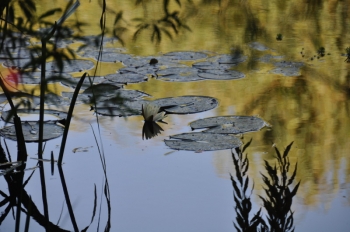 Water lilies are sensitive to cold. When the night is overcast and mild, they are all open in the morning. But if the night is clear, they close and need several hours of sunshine to open again.
Water lilies are sensitive to cold. When the night is overcast and mild, they are all open in the morning. But if the night is clear, they close and need several hours of sunshine to open again.
They like a warm water not only to open, but also to bloom. On Monet’s pond, water lilies are gorgeous during heat waves, they become scarce during rainy and cool periods.
This is true for a big pond like Giverny. For gardeners who would like to grow water lilies in a wash basin, it is wise to look for a partly shaded spot. In direct sunshine, the water of a small container becomes very warm. If some like it hot, it is not the case of water lilies.
by Ariane ~ June 13, 2011
[singlepic id=180 w=350 h=350 float=left]Standard roses are one of the beauties of Giverny.
As tall as trees, they measure over 2 meters and they offer their pink blossom like enormous bouquets.
Rose trees are generally not strong enough to resist wind, so they are grown on metallic structures that look like umbrellas or mushrooms, according to your imagination. Some people call them weeping roses, that’s really too sad.
In Monet’s flower garden, they tower over big bunches of peonies and large flower beds of pink and red poppies.
by Ariane ~ May 30, 2011
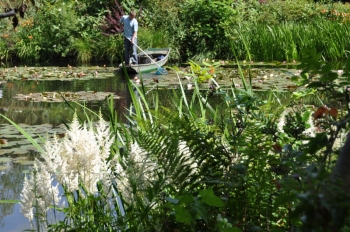 Monet’s Garden at Giverny is not a low maintainance garden. In the 19th Century, having gardeners and helpers was not as expensive as today. The wealthy painter could afford up to six full time gardeners to manucure his 5 acre garden.
Monet’s Garden at Giverny is not a low maintainance garden. In the 19th Century, having gardeners and helpers was not as expensive as today. The wealthy painter could afford up to six full time gardeners to manucure his 5 acre garden.
One of the heavy task of his times that is still a daily core today was the skimming of the pond to take out all the dried leaves or petals floating on the surface.
The pond being surrounded by trees and flowers, it is the only way to keep the water clear.
The job takes two hours and must be done almost every day.
by Ariane ~ April 30, 2011
[singlepic id=179 w=350 h=350 float=right]Frogs are very loud these days at Giverny.
The rest of the year, they are rather shy, and you rarely see them. But in Spring, especially in April, they croak.
The big bubbles the toad inflate on their cheeks betray them, although their color matches perfectly the water lilly pad they are seated on.
Their choir is not continuous. It sounds all of a sudden in the silent air. One frog starts, and quickly all the other ones reply, louder and louder. After a minute or two, they stop briskly.
I suppose they believe they sung harmoniously and are waiting for the applause of the visitors walking around Claude Monet’s pond.
by Ariane ~ April 15, 2011
[singlepic id=178 w=320 h=240 float=left]In the 19th Century, trees used to be white in Spring. There were white blossoms of cherry trees, white plum trees, white pear trees… Apple trees were slightly tinted with pink when budding, but became white when in bloom. Only southern trees like peach or apricot trees could be pink, however they were rarely to be seen in Normandy.
So we can imagine the novelty of introducing exotic varieties like crab apples, Japanese cherry or plum trees in a little village on the countryside like Giverny. Their pink blossom must have looked unique to Monet, and to his neighbours.
The pink exotic trees are widely spread by now, but in April their short beauty still enchants Spring in Claude Monet’s gardens.
by Ariane ~ April 3, 2011
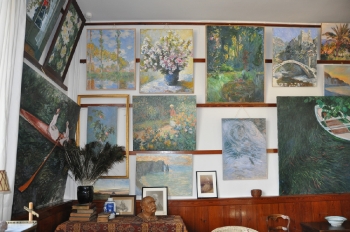 Sixty replicas, that is to say very good copies, have just been hung on the walls of Monet’s first studio at Giverny, making the place even more atmospheric.
Sixty replicas, that is to say very good copies, have just been hung on the walls of Monet’s first studio at Giverny, making the place even more atmospheric.
Untill last year, visitors could see prints on canvas on the walls. The new copies are now real paintings on canvas. They were made by a French gallery, galerie Trubetskoy in Paris. The chosen pictures were all in Monet’s own collection of his own work in his late years. These were the paintings he loved most and didn’t want to sell.
In addition, all the details of the studio have been checked on old photographs to be as accurate as possible. The result is stunning and really moving.
by Ariane ~ March 12, 2011
 If you are planning a visit to Monet’s garden in Giverny, you may wonder what is the best time of year to come. There are many! The scenery, the flower show change with the seasons. One of my favorite time is the tulip’s.
If you are planning a visit to Monet’s garden in Giverny, you may wonder what is the best time of year to come. There are many! The scenery, the flower show change with the seasons. One of my favorite time is the tulip’s.
Tulips flower mostly during the second half of April. Their blooming is spectacular, gorgeous, breathtaking. They offer colors, colors, colors, always bright ones, they can have soft and tender or very warm flaming tones. They exist in an infinite variety of forms and aspects. And they provide amazing mass effects.
This border, for instance, was designed by Monet after visiting and painting the tulip fields in Holland. He was impressed by the large colorful stripes of these cultures.
When he came back to Giverny, Monet decided he wanted a very long border in his garden, from top to bottom, planted according to a monochromatic scheme.
This oversized flower bed records to his visual experience in Holland, as far as color and size are concerned. But Monet could not be satisfied with one sort of tulips only. His ‘tulip field’ is a very refined mixed border composed of many different sorts of tulips. They harmonize, their pink is slightly different, producing the subtle variation of tones that one can observe on an impressionist painting. A beautiful example of the way Monet used flowers like brushstrokes.
by Ariane ~ March 6, 2011
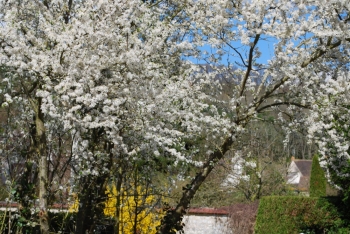 What is your idea of Giverny? A lady told me that before coming, she imagined Monet’s place isolated in the countryside, standing on its own like a chateau. She was surprised to discover it was part of a village.
What is your idea of Giverny? A lady told me that before coming, she imagined Monet’s place isolated in the countryside, standing on its own like a chateau. She was surprised to discover it was part of a village.
But this is no wonder, as Monet chose an existing house for his home. In the Seine valley, farms are not scattered around in the fields, but form villages of a few hundreds inhabitants. The rural dwelling is accompanied by a garden, where the peasant grows his vegetable and fruit.
This is exactly what fascinated Monet. When he discovered Giverny in April 1883, the fruit trees where in blossom, offering lovely views that attracted his painter’s eye.
Giverny hasn’t changed a lot through the decades. The village’s administration pays attention that it keeps its countryside mood, as quiet as possible. Except for the two museums and a few restaurants, you won’t find many tourism oriented places.
This is part of the charm of Giverny, sort of a feeling that things are still the same. A stroll through the main street of the village will lead you to the newly renovated nice little church.
by Ariane ~ February 19, 2011
[singlepic id=173 w=320 h=240 float=right]On April 1st, when it opens for the first time in the season, Giverny is like a sleeping beauty. Still a bit dreamy, it awakes gradually.
Lovers in their own dreams start walking around or sitting on the benches, enjoying the Spring sunshine.
Giverny is a nice place to celebrate love, love of a partner, of parents, relatives, and also love for gardens, nature, painting and simply beauty.
It was Valentine’s day this week: I dedicate this post to all lovers.
by Ariane ~ February 1, 2011
[singlepic id=172 w=320 h=240 float=right]Claude Monet ‘s pond at Giverny is almost completely frozen today, after a few cold days.
The last leaves of water lilies are petrified in the ice.
The garden looks asleep, while the gardeners are very busy. They maintain the bamboos that were bent by the snow, they remove the dry ones and take them away. It is a big job to carry away these 25 foot long sticks!
The gardeners have also chopped down the sick weeping willow to plant a new one, they cleansen the walkways, put the pansies in the flower beds…
The guardrails of the little curved bridge are missing. They are currently being repainted in the garage.
When I was in Monet’s garden this morning, I had the feeling of visiting a backstage, having a glimpse on a Giverny that nobody will see, the secret Giverny of wintertime.
by Ariane ~ January 28, 2011
[singlepic id=171 w=320 h=240 float=left]On April 1st, when Fondation Claude Monet opens again for a new season, it is early Spring.
On the hills of the Seine valley, the pastures are still grey, waiting for a new grass to grow.
But in Monet’s garden, the first flowers display their colors.
The weeping willows open their buds and swing their freshly born leaves over the pond.
On the river side, the small basket willows stretch their orange twigs.
These traditional trees are useful to prevent the banks from slipping into the river, and they are lovely too.
It is still Winter right now, but we are all looking forward to Spring.
by Ariane ~ January 27, 2011
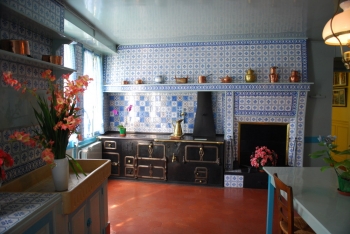 Very striking in Claude Monet’s kitchen at Giverny are the blue tiles that cover all the walls.
Very striking in Claude Monet’s kitchen at Giverny are the blue tiles that cover all the walls.
by Ariane ~ January 10, 2011
[singlepic=170,320,240,,right]This tree standing alone next to the greenhouse in Monet’s garden at Giverny is a holly.
Not a wild, ordinary one: it has beautiful golden rimmed leaves. Nonetheless, the holly disappears in the magnificence of flowers during the season, when the garden is in full bloom. Nobody takes any notice of the flowerless tree.
During the winter, on the contrary, when all the flowers are dead or waiting for better times to come, the holly recovers its majesty. This is probably why its prickly leaves and red berries are very much related to the time of Christmas and New Year.
by Ariane ~ December 31, 2010
[singlepic=169,350,350,,right]My German friend Veronika Stark painted this view of Monet’s garden under the snow.
It has been white for almost two weeks lately, but now the snow has gone.
I wish you all a wonderful celebration of New year’s Eve and a peaceful 2011. Hope to see you at Giverny!
by Ariane ~ December 14, 2010
 Monet
Monet
Thanks to Google maps, centered on Monet’s bust at Giverny, this is how Monet’s gardens look from a bird’s view. (it may take a while to load)
The pattern of flower beds looks very straight.
The green roof on the left is the greenhouse.
The big dark roof along rue Claude Monet is Monet’s home.
On the right you can see the big roof windows of his third studio.
If you drag the picture to the left you will visit the village of Giverny. The Museum of Impressionism has terrace roofs.
If you drag the picture to the bottom you will see the poplar grove that was chopped down last year.
Have a nice virtual tour of Giverny!
 Water lilies are sensitive to cold. When the night is overcast and mild, they are all open in the morning. But if the night is clear, they close and need several hours of sunshine to open again.
Water lilies are sensitive to cold. When the night is overcast and mild, they are all open in the morning. But if the night is clear, they close and need several hours of sunshine to open again.




 Monet
Monet